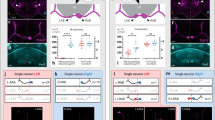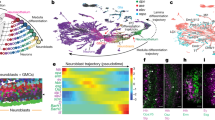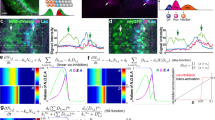Abstract
Developmental axon pruning is a general mechanism that is required for maturation of neural circuits. During Drosophila metamorphosis, the larval-specific dendrites and axons of early γ neurons of the mushroom bodies are pruned and replaced by adult-specific processes. We found that the nuclear receptor ftz-f1 is required for this pruning, activates expression of the steroid hormone receptor EcR-B1, whose activity is essential for γ remodeling, and represses expression of Hr39, an ftz-f1 homologous gene. If inappropriately expressed in the γ neurons, HR39 inhibits normal pruning, probably by competing with endogenous FTZ-F1, which results in decreased EcR-B1 expression. EcR-B1 was previously identified as a target of the TGFβ signaling pathway. We found that the ftz-f1 and Hr39 pathway apparently acts independently of TGFβ signaling, suggesting that EcR-B1 is the target of two parallel molecular pathways that act during γ neuron remodeling.
This is a preview of subscription content, access via your institution
Access options
Subscribe to this journal
Receive 12 print issues and online access
$209.00 per year
only $17.42 per issue
Buy this article
- Purchase on Springer Link
- Instant access to full article PDF
Prices may be subject to local taxes which are calculated during checkout







Similar content being viewed by others
References
Williams, D.W. & Truman, J.W. Remodeling dendrites during insect metamorphosis. J. Neurobiol. 64, 24–33 (2005).
Luo, L. & O'Leary, D.D. Axon retraction and degeneration in development and disease. Annu. Rev. Neurosci. 28, 127–156 (2005).
Lee, T., Marticke, S., Sung, C., Robinow, S. & Luo, L. Cell-autonomous requirement of the USP/EcR-B ecdysone receptor for mushroom body neuronal remodeling in Drosophila. Neuron 28, 807–818 (2000).
Zheng, X. et al. TGF-beta signaling activates steroid hormone receptor expression during neuronal remodeling in the Drosophila brain. Cell 112, 303–315 (2003).
Watts, R.J., Hoopfer, E.D. & Luo, L. Axon pruning during Drosophila metamorphosis: evidence for local degeneration and requirement of the ubiquitin-proteasome system. Neuron 38, 871–885 (2003).
Awasaki, T. et al. The Drosophila trio plays an essential role in patterning of axons by regulating their directional extension. Neuron 26, 119–131 (2000).
Watts, R.J., Schuldiner, O., Perrino, J., Larsen, C. & Luo, L. Glia engulf degenerating axons during developmental axon pruning. Curr. Biol. 14, 678–684 (2004).
Awasaki, T. et al. Essential role of the apoptotic cell engulfment genes draper and ced-6 in programmed axon pruning during Drosophila metamorphosis. Neuron 50, 855–867 (2006).
Schuldiner, O. et al. piggyBac-based mosaic screen identifies a postmitotic function for cohesin in regulating developmental axon pruning. Dev. Cell 14, 227–238 (2008).
Hoopfer, E.D., Penton, A., Watts, R.J. & Luo, L. Genomic analysis of Drosophila neuronal remodeling: a role for the RNA-binding protein Boule as a negative regulator of axon pruning. J. Neurosci. 28, 6092–6103 (2008).
Ito, K., Awano, W., Suzuki, K., Hiromi, Y. & Yamamoto, D. The Drosophila mushroom body is a quadruple structure of clonal units each of which contains a virtually identical set of neurones and glial cells. Development 124, 761–771 (1997).
Lee, T., Lee, A. & Luo, L. Development of the Drosophila mushroom bodies: sequential generation of three distinct types of neurons from a neuroblast. Development 126, 4065–4076 (1999).
Williams, D.W. & Truman, J.W. Cellular mechanisms of dendrite pruning in Drosophila: insights from in vivo time-lapse of remodeling dendritic arborizing sensory neurons. Development 132, 3631–3642 (2005).
Brown, H.L., Cherbas, L., Cherbas, P. & Truman, J.W. Use of time-lapse imaging and dominant negative receptors to dissect the steroid receptor control of neuronal remodeling in Drosophila. Development 133, 275–285 (2006).
King-Jones, K. & Thummel, C.S. Nuclear receptors—a perspective from Drosophila. Nat. Rev. Genet. 6, 311–323 (2005).
Horner, M.A., Chen, T. & Thummel, C.S. Ecdysteroid regulation and DNA binding properties of Drosophila nuclear hormone receptor superfamily members. Dev. Biol. 168, 490–502 (1995).
Yamada, M. et al. Temporally restricted expression of transcription factor betaFTZ-F1: significance for embryogenesis, molting and metamorphosis in Drosophila melanogaster. Development 127, 5083–5092 (2000).
Sullivan, A.A. & Thummel, C.S. Temporal profiles of nuclear receptor gene expression reveal coordinate transcriptional responses during Drosophila development. Mol. Endocrinol. 17, 2125–2137 (2003).
Ayer, S. et al. Activation and repression of Drosophila alcohol dehydrogenase distal transcription by two steroid hormone receptor superfamily members binding to a common response element. Nucleic Acids Res. 21, 1619–1627 (1993).
Ohno, C.K., Ueda, H. & Petkovich, M. The Drosophila nuclear receptors FTZ-F1 alpha and FTZ-F1 beta compete as monomers for binding to a site in the fushi tarazu gene. Mol. Cell. Biol. 14, 3166–3175 (1994).
Crispi, S., Giordano, E., D'Avino, P.P. & Furia, M. Cross-talking among Drosophila nuclear receptors at the promiscuous response element of the ng-1 and ng-2 intermolt genes. J. Mol. Biol. 275, 561–574 (1998).
Guichet, A. et al. The nuclear receptor homologue Ftz-F1 and the homeodomain protein Ftz are mutually dependent cofactors. Nature 385, 548–552 (1997).
Yang, M.Y., Armstrong, J.D., Vilinsky, I., Strausfeld, N.J. & Kaiser, K. Subdivision of the Drosophila mushroom bodies by enhancer-trap expression patterns. Neuron 15, 45–54 (1995).
Lee, T. & Luo, L. Mosaic analysis with a repressible cell marker for studies of gene function in neuronal morphogenesis. Neuron 22, 451–461 (1999).
Wang, J., Zugates, C.T., Liang, I.H., Lee, C.H. & Lee, T. Drosophila Dscam is required for divergent segregation of sister branches and suppresses ectopic bifurcation of axons. Neuron 33, 559–571 (2002).
Murata, T., Kageyama, Y., Hirose, S. & Ueda, H. Regulation of the EDG84A gene by FTZ-F1 during metamorphosis in Drosophila melanogaster. Mol. Cell. Biol. 16, 6509–6515 (1996).
Bellen, H.J. et al. The BDGP gene disruption project: single transposon insertions associated with 40% of Drosophila genes. Genetics 167, 761–781 (2004).
Horner, M. & Thummel, C.S. Mutations in the DHR39 orphan receptor gene have no effect on viability. Drosoph. Inf. Serv. 80, 35–37 (1997).
Allen, A.K. & Spradling, A.C. The Sf1-related nuclear hormone receptor Hr39 regulates Drosophila female reproductive tract development and function. Development 135, 311–321 (2008).
Lavorgna, G., Karim, F.D., Thummel, C.S. & Wu, C. Potential role for a FTZ-F1 steroid receptor superfamily member in the control of Drosophila metamorphosis. Proc. Natl. Acad. Sci. USA 90, 3004–3008 (1993).
Lam, G. & Thummel, C.S. Inducible expression of double-stranded RNA directs specific genetic interference in Drosophila. Curr. Biol. 10, 957–963 (2000).
Ueda, H., Sonoda, S., Brown, J.L., Scott, M.P. & Wu, C. A sequence-specific DNA-binding protein that activates fushi tarazu segmentation gene expression. Genes Dev. 4, 624–635 (1990).
Ueda, H. & Hirose, S. Defining the sequence recognized with BmFTZ-F1, a sequence specific DNA binding factor in the silkworm, Bombyx mori, as revealed by direct sequencing of bound oligonucleotides and gel mobility shift competition analysis. Nucleic Acids Res. 19, 3689–3693 (1991).
Thummel, C.S. Molecular mechanisms of developmental timing in C. elegans and Drosophila. Dev. Cell 1, 453–465 (2001).
Mehren, J.E., Ejima, A. & Griffith, L.C. Unconventional sex: fresh approaches to courtship learning. Curr. Opin. Neurobiol. 14, 745–750 (2004).
Davis, R.L. Olfactory memory formation in Drosophila: from molecular to systems neuroscience. Annu. Rev. Neurosci. 28, 275–302 (2005).
Gonzy-Tréboul, G., Lepesant, J.A. & Deutsch, J. Enhancer-trap targeting at the Broad Complex locus of Drosophila melanogaster. Genes Dev. 9, 1137–1148 (1995).
Nicolaï, M., Lasbleiz, C. & Dura, J.M. Gain-of-function screen identifies a role of the Src64 oncogene in Drosophila mushroom body development. J. Neurobiol. 57, 291–302 (2003).
Robertson, H.M. et al. A stable genomic source of P element transposase in Drosophila melanogaster. Genetics 118, 461–470 (1988).
Engels, W.R., Johnson-Schlitz, D.M., Eggleston, W.B. & Sved, J. High-frequency P element loss in Drosophila is homolog dependent. Cell 62, 515–525 (1990).
Talbot, W.S., Swyryd, E.A. & Hogness, D.S. Drosophila tissues with different metamorphic responses to ecdysone express different ecdysone receptor isoforms. Cell 73, 1323–1337 (1993).
Acknowledgements
We are particularly grateful to L. Fradkin for helpful discussions and comments on the manuscript. We thank L. Luo and T. Lee for babo, usp and several MARCM stocks; H. Ueda for the ftz-f1ex7FRT2A stock, the pUAST–βftz-f1 vector and the antibody to FTZ-F1; C. Woodard for the ftz-f119 stock; L. Pick for the UAS–αftz-f1 stock and the GST–FTZ-F1 expression vector; C. Thummel for the antibody to ECR-B1 (ascite fluid); B. Dickson for the antibody to TRIO; M. O'Connor for the UAS-babo-act (1B3 strong) and the UAS-baboΔI (2 transgenes 5A2–8A2) stocks and unpublished data pertaining to antibody to BABO and to babo transcripts and K. Matthews and K. Cook at the Bloomington Drosophila Stock Center. We also thank N. Lautredou at the Centre Régional d'Imagerie Cellulaire and J. Cau at the “Plateau d'Imagerie Cellulaire” for help with confocal imaging and P. Atger and C. Sarrauste de Menthière at the “service iconographie IGH”. Transgenic lines were generated by BestGene. This work was supported by the CNRS, grants from the Fondation pour la Recherche Médicale, the EEC Marie Curie 5th framework, the Association pour la Recherche sur le Cancer (n° 3744), the Association Française contre les Myopathies (MNM1 2007) and the Agence Nationale de la Recherche (ANR-07-NEURO-034-01). A.B. was supported by a postdoctoral fellowship from Fondation pour la Recherche Médicale, EEC Marie Curie 5th framework, from Association Française contre les Myopathies Agence Nationale de la Recherche. C.C.-R. was supported by a joint Ph.D. grant from the CNRS and Région Languedoc-Roussillon and then by a predoctoral Association pour la Recherche sur le Cancer fellowship.
Author information
Authors and Affiliations
Contributions
A.B., C.C.-R. and J.-M.D. designed the experiments and analyzed the data. C.F. and F.J. performed the chromatin immunoprecipitation experiments. J.-M.D. carried out the elaboration of the genetic stocks. A.B., C.C.-R., M.F., A.F. and T.G. performed all of the other experiments. The manuscript was written by J.-M.D. and commented on by A.B., C.C.-R. and A.F.
Corresponding author
Ethics declarations
Competing interests
The authors declare no competing financial interests.
Supplementary information
Supplementary Text and Figures
Supplementary Figures 1–16 and List of Fly Strains (PDF 1302 kb)
Rights and permissions
About this article
Cite this article
Boulanger, A., Clouet-Redt, C., Farge, M. et al. ftz-f1 and Hr39 opposing roles on EcR expression during Drosophila mushroom body neuron remodeling. Nat Neurosci 14, 37–44 (2011). https://doi.org/10.1038/nn.2700
Received:
Accepted:
Published:
Issue Date:
DOI: https://doi.org/10.1038/nn.2700
This article is cited by
-
Polycomb group genes are required for neuronal pruning in Drosophila
BMC Biology (2023)
-
5mC modification orchestrates choriogenesis and fertilization by preventing prolonged ftz-f1 expression
Nature Communications (2023)
-
Female factors modulate Sex Peptide’s association with sperm in Drosophila melanogaster
BMC Biology (2022)
-
Axonal chemokine-like Orion induces astrocyte infiltration and engulfment during mushroom body neuronal remodeling
Nature Communications (2021)
-
Genome-enabled insights into the biology of thrips as crop pests
BMC Biology (2020)



